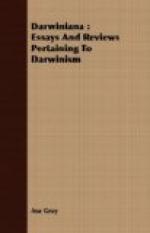As the facts stand, it appears that, while some tertiary forms are essentially undistinguishable from existing ones, others are the same with a difference, which is judged not to be specific or aboriginal; and yet others show somewhat greater differences, such as are scientifically expressed by calling them marked varieties, or else doubtful species; while others, differing a little more, are confidently termed distinct, but nearly-related species. Now, is not all this a question of degree, of mere gradation of difference? And is it at all likely that these several gradations came to be established in two totally different ways—some of them (though naturalists can’t agree which) through natural variation, or other secondary cause, and some by original creation, without secondary cause? We have seen that the judicious Pictet answers such questions as Darwin would have him do, in affirming that, in all probability, the nearly-related species of two successive faunas were materially connected, and that contemporaneous species, similarly resembling each other, were not all created so, but have become so. This is equivalent to saying that species (using the term as all naturalists do, and must continue to employ the word) have only a relative, not an absolute fixity; that differences fully equivalent to what are held to be specific may arise in the course of time, so that one species may at length be naturally replaced by another species a good deal like it, or may be diversified into two, three, or more species, or forms as different as species. This concedes all that Darwin has a right to ask, all that he can directly infer from evidence. We must add that it affords a locus standi, more or less tenable, for inferring more.
Here another geological consideration comes in to help on this inference. The species of the later tertiary period for the most part not only resembled those of our days—many of them so closely as to suggest an absolute continuity—but also occupied in general the same regions that their relatives occupy now. The same may be said, though less specially, of the earlier tertiary and of the later secondary; but there is less and less localization of forms as we recede, yet some localization even in palaeozoic times. While in the secondary period one is struck with the similarity of forms and the identity of many of the species which flourished apparently at the same time in all or in the most widely-separated parts of the world, in the tertiary epoch, on the contrary, along with the increasing specialization of climates and their approximation to the present state, we find abundant evidence of increasing localization of orders, genera and species, and this localization strikingly accords with the present geographical distribution of the same groups of species Where the imputed forefathers lived their relatives and supposed descendants now flourish All the actual classes of the animal and vegetable kingdoms were represented in the tertiary




